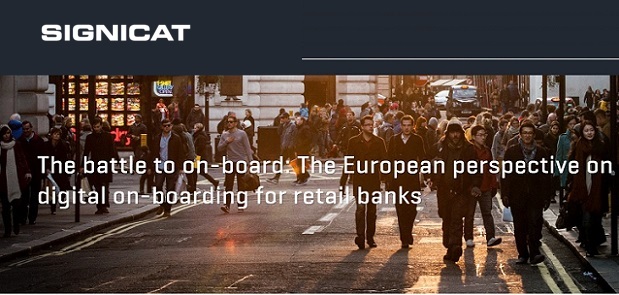
New report from Signicat conducted at the height of COVID-19 sees abandonment rate increase by 23 percentage points from 2019.
One in five abandonments are due to a lengthy and complicated onboarding process.
41% of consumers across Europe have been unable to access new financial services due to lockdown restrictions and lack of digital options.
Signicat, the Trusted Digital Identity™ company, today revealed new research that shows 63% of consumers in Europe have abandoned financial applications in the past year. The survey results—conducted in May and June 2020 during Europe-wide COVID-19 restrictions—are the worst since the report debuted in 2016 and show a sharp increase of 23 points from the 40% abandonment rate in 2019.
The fourth edition of Signicat’s annual study The Battle to Onboard 2020: The impact of COVID-19 and beyond is based on a survey of 4,000 adults across Belgium, Finland, Germany, the Netherlands, Norway, Sweden and the United Kingdom regarding their onboarding experience as well as their attitude towards financial service providers.
For any business, knowing your customer (KYC) is challenging. Financial institutions must comply with KYC and Anti Money Laundering (AML) rules which requires the consumer shares personal information. All too often identity checking processes are not designed for the digital world:
. Over a quarter (26%) of consumers argue that the onboarding process is “difficult”.
. Over a quarter feel the onboarding process is longer than they expected (28%).
. Consumers have been spoiled by the ease of mobile-first financial service providers. Over two thirds (69%) consider mobile-first providers to be better than more traditional providers.
. Consumers are finally refusing to put up with substandard options—something Signicat believes is the end of “learned helplessness”.
Learned helplessness is a phenomenon where if people find themselves in a negative situation for any length of time, they believe that they cannot change this situation—even if better options become available. The increased use of digital brands—effectively better options—is changing this attitude in consumers.
. Far more consumers are now using a mobile-first financial service, up from 30% in 2019 to 47% in 2020.
. Only 4% are unhappy with their new mobile-first provider. 69% are happier than before.
. 70% of those with a digital-first account say that convenience means they are more likely to use it every day.
As a result, we are seeing the “the end of learned helplessness”. Consumers have simply had enough of poor onboarding experiences and have begun voting with their feet. Banks have not responded sufficiently to this change.
The panic around meeting the expectations of millennials—the first digital natives—has been misplaced. Lots of ink has been spilled on their expectations and how this should shape how businesses work. It’s actually the generation after, known as Gen Z (18-24-year-olds), that are the real worry for institutions. This group will represent 30% of the world’s population and will make up a third of all global consumers by the end of the next decade.
This year’s survey findings indicate a growing expectation gap between demographics. Older groups—including millennials—are burdened with “learned helplessness” and are more inclined to put up with inadequate onboarding experiences. Whereas Gen Z show little tolerance for anything other than fast digital onboarding:
. Over a third of these younger consumers feel the onboarding process is longer than they expected (36%).
. Just under a quarter of Gen Z customers are abandoning applications due to lengthy processes (24%).
. They are also more likely to be deterred by too much detail (22%), and most likely to simply change their minds (24%).
Branch usage was already declining steadily before this year, with customers increasingly using digital channels to manage their finances. The pandemic has only accelerated this process and forced consumers to think about how they engage with financial services.
. Lockdown restrictions has meant 41% of consumers were unable to access financial services.
. Two thirds (68%) see pandemic-driven change as inevitable and expect 100% digital onboarding to be introduced.
“This year we have all been forced to start doing everyday tasks differently. For many that has meant managing the entirety of their financial lives using remote channels for the first time. And this is where some financial service providers’ offerings have been found lacking,” said Sarah Kocianski, Head of Research, 11:FS.
“Onboarding, in particular, is crucial. If customers can’t or won’t open new accounts, these organisations will struggle to cope with further economic turmoil. And it’s not just the pandemic that providers have to get their heads around, other, pre-pandemic factors which have not been addressed are exacerbating potential customers’ failure to complete onboarding.”
“In short, providers should prioritise ensuring customers can apply, open, and start using accounts quickly and digitally if they want to compete in today’s environment,” concludes Kocianski.
“In the time since Signicat started the Battle to Onboard series of reports, we’ve seen some indications of improvement, with traditional financial institutions running as fast as they can to keep up with growing consumer expectations,” said Asger Hattel, CEO, Signicat. “Institutions have clearly improved their on-boarding processes. But customer expectations continue to outpace reality—largely due to the digital-first onboarding experience offered by challenger banks and fintechs. Financial services providers simply need to run much faster to avoid losing out on new customers.”
Banking 4.0 – „how was the experience for you”
„To be honest I think that Sinaia, your conference, is much better then Davos.”
Many more interesting quotes in the video below: